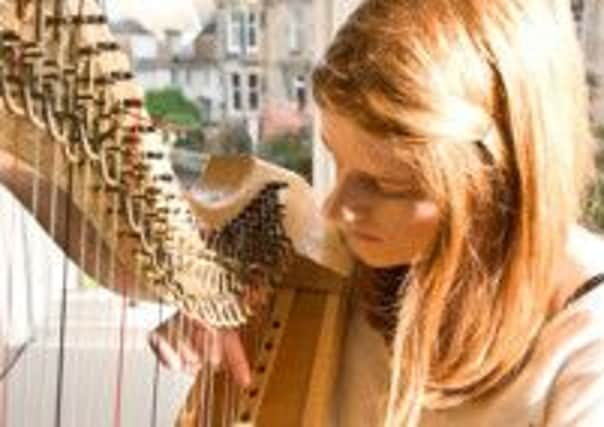Disabled musicians find an Equilibrium


In an Edinburgh rehearsal studio, that most timeless of instruments, the harp, is chiming alongside the digitised sounds of 21st-century technology. This highly innovative ensemble calls itself Equilibrium, striking as it does a unique balance and rapport between Edinburgh harpist and composer Fiona Rutherford and two disabled yet determinedly creative young players, Amy Moar and Rhona Smith.
The three are rehearsing a commission for the forthcoming Edinburgh International Harp Festival, written by Rutherford specifically to be performed on stage by Moar and Smith along with a further three harpists from George Watson’s School, where the 29-year-old Rutherford teaches, and the Festival Harp Orchestra. They’re doing it with the help of Drake Music Scotland, an Edinburgh-based charity which carries out often astonishing work in enabling disabled adults and children to play and compose music, and in whose Craigmillar studio the rehearsal is taking place.
Advertisement
Hide AdLaptops are much in evidence, as well some far less orthodox devices, designed to assist even the most challenged in terms of mobility to create music. Pete Sparkes, artistic director of Drake Music Scotland, is busy adjusting an ultrasonic soundbeam for Moar to use, enabling her to play scales and other note sequences in whatever pre-programmed instrumental tone is required, by moving her hand up and down over its sensor.
Moar, who is 22, is registered as blind and suffers from other health issues. However, she is studying for a BA in music at Edinburgh College linked to the University of Abertay, and is a seasoned singer and performer on piano and harp (she sang before the Dalai Lama in Edinburgh in 2004). She has a small clarsach with her, which she’ll also play in the piece, but for now she’s familiarising herself with the soundbeam, which emits gurgly arpeggios as she seeks pitch, amid some hilarity. She’s asked Sparkes to programme it with a cello sound.
Sparkes loads the score so far onto Smith’s laptop, using Notion software for musical composition, enabling Smith, whose quadriplegic dystonic cerebral palsy severely affects her muscle control, to operate a switch from her wheelchair to change phrasing or emphasis, or create crescendo and diminuendo, as she watches the laptop score. As Moar puts it, “the switch is Rhona’s Baton”.
They listen through what Rutherford says is a kind of first draft. Provisionally titled Motion, at least part of it certainly has a slightly minimalist sense of pulse and movement. Fiona also likes the title “because it kind of reflects the harp as an ancient instrument, but we’re using it with 21st century technology.”
I have previously heard Smith perform as part of the Digital Quartet, a group of variously disabled players, at the launch of their CD, The Deep, three movements of atmospheric, ambient and strangely moving electronic music which they devised and recorded in collaboration with Drake. Motion is very different, although using some of the same technology.
Moar switches from soundbeam to harp, and starts picking out a Celtic-sounding slow air she’s learned from Rutherford, over a sonorous boom of sampled bass strings controlled by Smith. Moar doesn’t seem to have any problems with improvisation, although Rutherford reckons that for her pupils from George Watson’s who will be taking part in the finished piece, it will be new concept. But the whole experience of this commission, she says, “is a learning exercise for me as much as for the others”.
Advertisement
Hide AdFor Sparkes, developing a piece in this way as well as the technology to enable it to be performed “is about getting back to the very basics of what is music and what musicians need to play together.”
Drake Music’s role is pivotal in enabling these players to transcend their disabilities. As Smith puts it, “It makes me feel equal to my able-bodied peers who also play music.”
Advertisement
Hide AdMoar agrees: “I feel like there are no barriers and, in a way, music is extremely therapeutic for me, because I have other ongoing health issues and it helps me to escape from some of these physical and mental challenges.”
Rutherford’s own album, Sleep Sound, based on her New Voices commission for the 2012 Celtic Connections festival, has just been released, an impressionistic exploration of sleep and dreamtime. In the meantime, as well as premiering Motion, she and Sparkes will give an Equilibrium workshop during the 33rd Edinburgh Harp Festival, which runs from 4-9 April at its annual venue of Merchiston Castle School and, as ever, features an eclectic range of Celtic, Scandinavian, Latin-American, classical and other harp styles, as well as a week of courses and workshops.
• For further information see www.harpfestival.co.uk; www.drakemusicscotland.org; www.fionarutherford.com